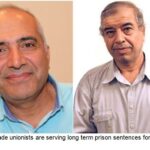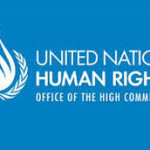
AMNESTY INTERNATIONAL
PRESS RELEASE
29 April 2021
Iranian authorities are banning members of the persecuted Baha’i minority from burying their loved ones in empty plots at a cemetery near Tehran that they have used for decades, instead insisting they bury them between existing graves within the cemetery or at the nearby Kharavan mass grave site for victims of the 1988 prison massacres, said Amnesty International today.
The Kharavan mass grave site, which is believed to contain the remains of up to several hundred victims of the mass enforced disappearances and secret extrajudicial executions of 1988, has been bulldozed multiple times in recent decades and has gained national significance in the struggle for truth and justice. By pressuring Baha’i families to bury their loved ones there, Iranian authorities are putting the mass grave site at further risk of destruction, tampering with vital forensic evidence, and continuing to commit the crimes against humanity of enforced disappearance, torture and other inhumane acts against the families of those forcibly disappeared and secretly killed.
“This is the latest in a series of criminal attempts over the years by Iran’s authorities to destroy mass grave sites of victims of the 1988 prison massacres in a bid to eliminate crucial evidence of crimes against humanity, denying truth, justice and reparation to the families of those forcibly disappeared and extrajudicially executed in secret,” said Amnesty International’s Deputy Director for the Middle East and North Africa, Diana Eltahawy.
“As well as causing further pain and anguish to the already persecuted Baha’i minority by depriving them of their rights to give their loves ones a dignified burial in line with their religious beliefs, Iran’s authorities are wilfully destroying a crime scene.”
Family members who visited the mass grave site on 23 April saw eight freshly dug empty graves and two new graves marked by a sign indicating the name of the deceased. Photographs reviewed by Amnesty International corroborated this, and showed lines drawn in the dirt to mark future graves as well. Families also noted an increased security and intelligence presence at site over the past couple of months.
Amnesty International spoke to a Baha’i human rights group and families of victims of the 1988 prison massacres based outside Iran, who received credible information from those who visited the grave site on 23 April, as well as reviewing photographic evidence. Due to a prevailing climate of fear and reprisals by the authorities against those speaking out, the organization was unable to speak directly to affected families inside Iran.
Baha’is prevented from holding dignified burials
Last month, in a significant departure from established practice, a high-ranking official at the Organization of Behesht Zahra , a state body which regulates burials in Tehran, prohibited Bahai’s from burying loved ones in the empty plots at Golestan Javid cemetery, according to the NGO Baha’i International Community (BIC). The official said that from now on, they must either squeeze them in between existing graves within the cemetery or bury them in the Khavaran mass grave site. The lack of space between existing graves at Golestan Javid cemetery leaves families with no real alternative to burying their deceased at the mass grave site.
The Baha’i community has strongly objected to the authorities’ efforts to coerce them into desecrating the Kharavan mass grave site. Amnesty International has received distressing reports from BIC, of bodies languishing in morgues as Baha’i families refuse to bury their loved ones in the mass grave site.
At least one Baha’i family reported that in April a deceased family member was buried without their knowledge or consent in an abandoned area outside Golestan Javid cemetery, without Baha’i burial rites and customs, because the family refused to be complicit in the destruction of the Khavaran mass grave.
Under Iranian law, burials must only take place with the written permission of official bodies in official gravesites and cemeteries. Those accused of carrying out unlawful burials can face criminal prosecution leading to detention and fines.
“The international community must press the Iranian authorities including the municipal authorities in Tehran and other cities, as well as the Ministry of Interior, which oversees the management of grave sites in the country, to recognize and treat Khavaran and other mass grave sites across Iran as crime scenes. Professional forensic expertise is required to undertake exhumations and ensure that evidence is preserved and bodies correctly identified,” said Diana Eltahawy.
“The Iranian authorities must also immediately allow members of the Baha’I minority to take part in burial and mourning rituals and customs according to their beliefs and put an end to their systematic persecution.”
For decades religious minorities in Iran, including Baha’is, have had their own designated cemeteries because cemeteries used for the burial of Muslims cannot accommodate their different rituals for the washing and burial of the dead. Authorities of the Islamic republic also consider them “filthy” and believe that they should not be buried alongside Muslims. The authorities refer to the area encompassing Golestan Javid cemetery and Khavaran mass grave site as “damned land” (la’nat abad). The whole area is managed by the Organization of Behesht Zahra.
Over the past four decades, the Iranian authorities have repeatedly desecrated and demolished Baha’i cemeteries across the country. On multiple occasions, the authorities have also subjected the bodies of members of the Baha’i community to desecration and degrading treatment including by preventing them from being buried or unlawfully exhuming them and transferring them to abandoned areas.
By preventing the Baha’i minority from burying their loved ones in dignity and in accordance with their religious rituals and customs, the Iranian authorities are violating Article 15 of the International Covenant on Economic, Social and Cultural Rights and Article 27 of the International Covenant on Civil and Political Rights, both of which Iran has ratified. These actions also constitute cruel, inhuman or degrading treatment prohibited under international law.
These abuses are taking place in the context of broader patterns of systematic and widespread human rights violations against members of the Baha’i minority, including arbitrary arrest and detention, forcible closure of businesses, confiscation of property, bans on employment in the public sector, denial of access to higher education, and hate speech campaigns on state media.
International action needed for Iran’s crimes against humanity
In a 2018 report Amnesty International concluded that in addition to committing the crime against humanity of murder in 1988 by forcibly disappearing and extrajudicially executing thousands of political dissidents, the Iranian authorities are committing the ongoing crimes against humanity of enforced disappearance, persecution, torture and other inhumane acts, including by continuing to conceal the fate and whereabouts of victims.
Given the prevailing climate of systematic impunity in Iran, Amnesty International reiterates its call on UN Human Rights Council member states to urgently set up a mechanism for gathering and analysing evidence of past and ongoing human rights violations and crimes, including those related to the 1988 prison massacres, in order to enable prosecutions of those responsible and provide long overdue justice and reparation for the victims.
“More than 33 years on, these crimes against humanity remain an open wound in Iran amid a crisis of systematic impunity. Those against whom there is evidence of direct involvement with these crimes continue to hold top positions of power. They include the current head of the judiciary and minister of justice, whose roles are vital for the pursuit of justice,” said Diana Eltahawy.












 Posted in
Posted in 











